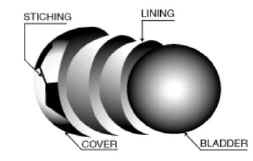
-
-


-
-
|
Soccer Ball Manufacturing
 We’re so used to seeing soccer balls in our every day life that it’s easy to take them for granted. But how does a soccer ball come into this world? How are they created in such perfect spheres, with seamless stitching in that unmistakable black and white pattern? Believe it or not, machines are not the answer. Most professional-grade soccer balls are still made by hand, which accounts for their top-notch quality control. And it’s a surprisingly complex process. We’re so used to seeing soccer balls in our every day life that it’s easy to take them for granted. But how does a soccer ball come into this world? How are they created in such perfect spheres, with seamless stitching in that unmistakable black and white pattern? Believe it or not, machines are not the answer. Most professional-grade soccer balls are still made by hand, which accounts for their top-notch quality control. And it’s a surprisingly complex process.
The first step in making a soccer ball is perhaps the most unusual. Soccer balls are made from the inside-out, meaning that the first piece to be constructed is the covering. In the vast majority of cases, thirty-two individual pieces are sewn together – twenty of them are six-sided hexagons, which are colored white, while the other twelve are five-sided pentagons, which are usually tinted black. (Sometimes, a design or logo is imprinted on the hexagons instead of basic black.) The pieces used to be cut from animal hides, but real leather would tend to absorb water and get extremely heavy when wet. Nowadays, synthetic leather is used instead. These pieces are generally cut and perforated (for the stitching) by a machine, in order to ensure that each piece is the right shape, but the stitching is done by hand.
The synthetic leather pieces also have several layers of cloth glued on as a backing. The general rule is that more layers produce a higher-quality soccer ball. However, there can’t be too many layers, because the pieces have to be somewhat flexible. This is because when they’re stitched together, the thirty-two pieces create a shape known as a truncated icosahedron. This shape usually would have many sharp points on its surface, but because the pieces are flexible, they can curve to form a perfect sphere. This flexible truncated icosahedron, made of synthetic leather and several pieces of cloth, becomes the covering, the outer layer and the most recognizable part of a soccer ball.
The question then becomes: how is enough pressure applied from the inside to curve the covering outwards, creating the spherical shape? To do so, an inflatable rubber pouch – called a “bladder” – is inserted inside the covering before the final pieces are stitched together. The rubber bladder should be airtight, except for a small valve used to inflate it. Essentially, the bladder is like a thick balloon designed to be inflated and deflated multiple times. After it’s glued onto the inner layer of the covering, the last few pieces are sewn together on top of it, leaving only a tiny hole for the air valve. When air is pumped into the valve, the ball inflates and becomes taut.
The balls are stitched together using polyester thread, with a 5-ply polyester twist considered the highest quality available. Methods other than traditional stitching are used, though less frequently. Some soccer ball manufacturers have experimented with glued panels and machine-stitching, techniques which are cost-effective but result in a lower-quality product. In addition, other companies have developed a “thermal molding” method of fusing the coverings together, which produces a very high-quality ball, but is extremely expensive.
|



